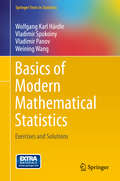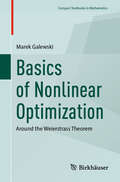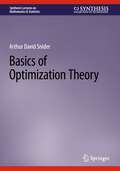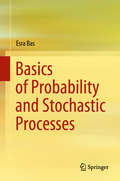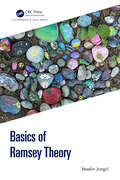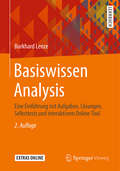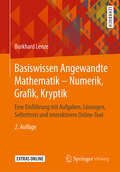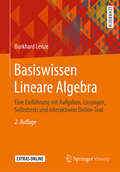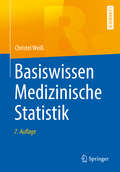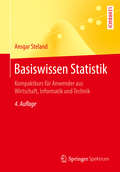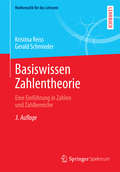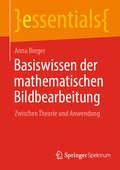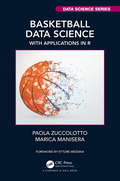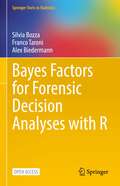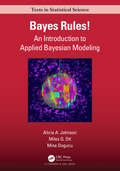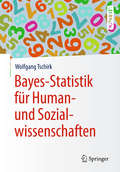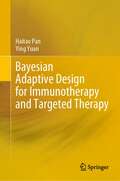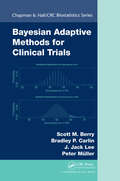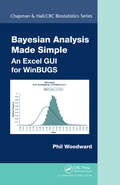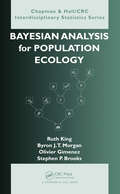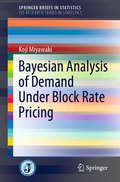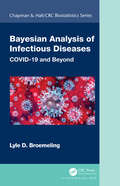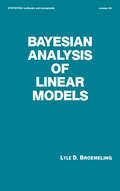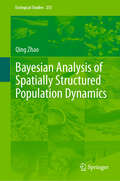- Table View
- List View
Basics of Modern Mathematical Statistics: Exercises and Solutions (Springer Texts in Statistics)
by Wolfgang Karl Härdle Vladimir Spokoiny Vladimir Panov Weining WangThe complexity of today's statistical data calls for modern mathematical tools. Many fields of science make use of mathematical statistics and require continuous updating on statistical technologies. Practice makes perfect, since mastering the tools makes them applicable. Our book of exercises and solutions offers a wide range of applications and numerical solutions based on R. In modern mathematical statistics, the purpose is to provide statistics students with a number of basic exercises and also an understanding of how the theory can be applied to real-world problems. The application aspect is also quite important, as most previous exercise books are mostly on theoretical derivations. Also we add some problems from topics often encountered in recent research papers. The book was written for statistics students with one or two years of coursework in mathematical statistics and probability, professors who hold courses in mathematical statistics, and researchers in other fields who would like to do some exercises on math statistics.
Basics of Nonlinear Optimization: Around the Weierstrass Theorem (Compact Textbooks in Mathematics)
by Marek GalewskiThis textbook gives an introduction to optimization tools which arise around the Weierstrass theorem about the minimum of a lower semicontinuous function. Starting from a Euclidean space, it moves further into the infinite dimensional setting towards the direct variational method, going through differentiation and introducing relevant background information on the way. Exercises accompany the text and include observations, remarks, and examples that help understand the presented material. Although some basic knowledge of functional analysis is assumed, covering Hilbert and Banach spaces and the Lebesgue integration, the required background material is covered throughout the text, and literature suggestions are provided. For less experienced readers, a summary of some optimization techniques is also included. The book will appeal to both students and instructors in specialized courses on optimization, wishing to learn more about variational methods.
Basics of Optimization Theory (Synthesis Lectures on Mathematics & Statistics)
by Arthur David SniderThis book presents a short introduction to the main tools of optimization methodology including linear programming, steepest descent, conjugate gradients, and the Karush-Kuhn-Tucker-John conditions. Each topic is developed in terms of a specific physical model, so that the strategy behind every step is motivated by a logical, concrete, easily visualized objective. A quick perusal of the Fibonacci search algorithm provides a simple and tantalizing first encounter with optimization theory, and a review of the max-min exposition of one-dimensional calculus prepares readers for the more sophisticated topics found later in the book. Notable features are the innovative perspectives on the simplex algorithm and Karush-Kuhn-Tucker-John conditions as well as a wealth of helpful diagrams. The author provides pointers to references for readers who would like to learn more about rigorous definitions, proofs, elegant reformulations and extensions, and case studies. However, the book is sufficiently self-contained to serve as a reliable resource for readers who wish to exploit commercially available optimization software without investing the time to develop expertise in its aspects.This book also:Features innovative perspectives on the simplex algorithm and Krushal-Kuhn-Tucker-John conditionsServes as a resource for readers to use the tools of optimization without needing to acquire expertise in the theoryFeatures plentiful resources that focus on rigorous definitions, proofs, and case studies
Basics of Probability and Stochastic Processes
by Esra BasThis textbook explores probability and stochastic processes at a level that does not require any prior knowledge except basic calculus. It presents the fundamental concepts in a step-by-step manner, and offers remarks and warnings for deeper insights. The chapters include basic examples, which are revisited as the new concepts are introduced. To aid learning, figures and diagrams are used to help readers grasp the concepts, and the solutions to the exercises and problems. Further, a table format is also used where relevant for better comparison of the ideas and formulae. The first part of the book introduces readers to the essentials of probability, including combinatorial analysis, conditional probability, and discrete and continuous random variable. The second part then covers fundamental stochastic processes, including point, counting, renewal and regenerative processes, the Poisson process, Markov chains, queuing models and reliability theory. Primarily intended for undergraduate engineering students, it is also useful for graduate-level students wanting to refresh their knowledge of the basics of probability and stochastic processes.
Basics of Ramsey Theory
by Veselin JungićBasics of Ramsey Theory serves as a gentle introduction to Ramsey theory for students interested in becoming familiar with a dynamic segment of contemporary mathematics that combines ideas from number theory and combinatorics. The core of the of the book consists of discussions and proofs of the results now universally known as Ramsey’s theorem, van der Waerden’s theorem, Schur’s theorem, Rado’s theorem, the Hales–Jewett theorem, and the Happy End Problem of Erdős and Szekeres. The aim is to present these in a manner that will be challenging but enjoyable, and broadly accessible to anyone with a genuine interest in mathematics. Features Suitable for any undergraduate student who has successfully completed the standard calculus sequence of courses and a standard first (or second) year linear algebra course. Filled with visual proofs of fundamental theorems. Contains numerous exercises (with their solutions) accessible to undergraduate students. Serves as both a textbook or as a supplementary text in an elective course in combinatorics and aimed at a diverse group of students interested in mathematics.
Basiswissen Analysis: Eine Einführung mit Aufgaben, Lösungen, Selbsttests und interaktivem Online-Tool
by Burkhard LenzeDieses Buch bietet eine schlanke und gut zugängliche Hinführung zur Analysis. Gut 100 komplett durchgerechnete Beispiele, etwa 50 Aufgaben mit Lösungen sowie rund 40 kleine Selbsttests mit Antworten erleichtern den Zugang zum Thema. Abgerundet wird das Ganze durch etwa 80 Skizzen im Text sowie ein online verfügbares interaktives pdf-Tool zum Generieren von Zufallsaufgaben inklusive Lösungen. Das Buch richtet sich an Studierende in Studiengängen mit mathematischen Pflichtveranstaltungen im Grundstudium an Universitäten und Fachhochschulen. Es ist sowohl als Begleitlektüre für entsprechende Vorlesungen als auch zum Selbststudium optimal geeignet.
Basiswissen Angewandte Mathematik – Numerik, Grafik, Kryptik: Eine Einführung mit Aufgaben, Lösungen, Selbsttests und interaktivem Online-Tool
by Burkhard LenzeDieses Buch bietet eine schlanke und gut zugängliche Hinführung zur Angewandten Mathematik, speziell zur Numerischen Mathematik, Aspekten der Computer-Grafik sowie der Verschlüsselungstechnik. Rund 140 komplett durchgerechnete Beispiele, gut 100 Aufgaben mit Lösungen sowie etwa 50 Selbsttests mit Lösungen erleichtern den Zugang zum Thema. Abgerundet wird das Ganze durch etwa 80 Skizzen im Text sowie ein online verfügbares interaktives pdf-Tool zum Generieren von Zufallsaufgaben inklusive Lösungen. Das Buch richtet sich an Studierende in Studiengängen mit mathematischen Pflichtveranstaltungen im Grundstudium an Universitäten und Fachhochschulen. Es ist sowohl als Begleitlektüre für entsprechende Vorlesungen als auch zum Selbststudium optimal geeignet.
Basiswissen Lineare Algebra: Eine Einführung mit Aufgaben, Lösungen, Selbsttests und interaktivem Online-Tool
by Burkhard LenzeDieses Buch bietet eine schlanke und gut zugängliche Hinführung zur Linearen Algebra. Knapp 200 komplett durchgerechnete Beispiele, gut 100 Aufgaben mit Lösungen sowie rund 50 Selbsttests mit Lösungen erleichtern den Zugang zum Thema. Abgerundet wird das Ganze durch etwa 60 Skizzen im Text sowie ein online verfügbares interaktives pdf-Tool zum Generieren von Zufallsaufgaben inklusive Lösungen. Das Buch richtet sich an Studierende in Studiengängen mit mathematischen Pflichtveranstaltungen im Grundstudium an Universitäten und Fachhochschulen. Es ist sowohl als Begleitlektüre für entsprechende Vorlesungen als auch zum Selbststudium optimal geeignet.
Basiswissen Medizinische Statistik (Springer-Lehrbuch)
by Christel WeißÜbersichtlich und kompakt bietet Ihnen dieses Lehrbuch einen vollständigen Überblick über alle prüfungsrelevanten Inhalte der medizinischen Statistik. Es leitet Sie leicht verständlich und praxisbezogen durch das gesamte Basiswissen von den Grundlagen bis hin zu den wichtigsten Anwendungen. Profitieren Sie von der langjährigen Erfahrung der Dozentin, die sorgfältig das Wesentliche für Sie ausgewählt und aufbereitet hat.Der InhaltDas bewährte didaktische Konzept ermöglicht ein effizientes Lernen:Kernaussagen – Bringen das Wichtigste auf den PunktFallbeispiele – Stellen einen anschaulichen Bezug zur Praxis herPrüfungsteil – Für eine optimale Vorbereitung auf MC-Fragen und mündliche PrüfungenDie AutorinProf. Dr. sc. Hum. Habil. Dipl.- Math. Christel Weiß ist die Leiterin der Abteilung für Medizinische Statistik, Biomathematik und Informationsverarbeitung des Universitätsklinikums Mannheim, Medizinische Fakultät der Universität Heidelberg.
Basiswissen Statistik: Kompaktkurs für Anwender aus Wirtschaft, Informatik und Technik (Springer-Lehrbuch)
by Ansgar StelandIn diesem Buch werden in kompakter Form mithilfe zahlreicher Beispiele die #65533;blichen Modelle und Methoden der angewandten Wahrscheinlichkeitstheorie und Statistik dargestellt. Es ist daher insbesondere f#65533;r angehende Wirtschaftswissenschaftler, Ingenieure und Informatiker geeignet, welchen auch das didaktische Konzept des Buchs entgegenkommt: Verst#65533;ndnisfragen und Aufgaben in Form von ,,Meilensteinen" erleichtern das eigenst#65533;ndige #65533;berpr#65533;fen des Lernfortschritts. Ein ausf#65533;hrlicher mathematischer Anhang ,,Mathematik kompakt" stellt die wichtigsten Ergebnisse aus Analysis und linearer Algebra zum effizienten Nachschlagen zur Verf#65533;gung. Ein Glossar mit den wichtigsten englischen Begriffen sowie Tabellen der statistischen Testverteilungen runden die Darstellung ab.
Basiswissen Zahlentheorie: Eine Einführung in Zahlen und Zahlbereiche (Mathematik für das Lehramt)
by Kristina Reiss Gerald SchmiederKenntnisse über den Aufbau des Zahlensystems und über elementare zahlentheoretische Prinzipien gehören zum unverzichtbaren Grundwissen in der Mathematik. Das vorliegende Buch spannt den Bogen vom Rechnen mit natürlichen Zahlen über Teilbarkeitseigenschaften und Kongruenzbetrachtungen bis hin zu zahlentheoretischen Funktionen und Anwendungen wie der Kryptographie und Zahlencodierung. Wert wird dabei auf eine verständliche und umfassende Darstellung des Stoffes gelegt. Beweisideen, die hinter stringent durchgeführten Beweisen stehen und die Verknüpfung von Fachwissen mit Schulbezügen sind dabei als besondere Merkmale hervorzuheben. Ergänzt wird die Darstellung durch viele Übungsaufgaben, die mit Lösungshinweisen und vollständigen Lösungen versehen sind.
Basiswissen der mathematischen Bildbearbeitung: Zwischen Theorie und Anwendung (essentials)
by Anna BregerMithilfe dieses kompakten Buchs wird ein erstes strukturiertes Verständnis für die mathematischen Grundlagen digitaler Bilder und deren weitere Bearbeitung vermittelt. Ziel des Buchs ist es Interesse zu wecken und eine Basis zu geben um sich in Folge vertiefend mit digitaler und mathematischer Bildbearbeitung auseinander setzen zu können. Als alleinstehendes Werk ist es geeignet einen ersten Einblick in die Hintergründe der mittlerweile alltäglichen Bearbeitung von digitalen Bildern zu bekommen. Für das Verständnis der Inhalte ist ein elementares Wissen aus Linearer Algebra von Vorteil. Alle besprochenen Themen werden mathematisch motiviert und visuell dargestellt.
Basketball Data Science: With Applications in R (Chapman & Hall/CRC Data Science Series)
by Paola Zuccolotto Marica ManiseraUsing data from one season of NBA games, Basketball Data Science: With Applications in R is the perfect book for anyone interested in learning and applying data analytics in basketball. Whether assessing the spatial performance of an MBA player&’s shots or doing an analysis of the impact of high pressure game situations on the probability of scoring, this book discusses a variety of case studies and hands-on examples using a custom R package. The codes are supplied so readers can reproduce the analyses themselves or create their own. Assuming a basic statistical knowledge, Basketball Data Science with R is suitable for students, technicians, coaches, data analysts and applied researchers. Features: · One of the first books to provide statistical and data mining methods for the growing field of analytics in basketball. · Presents tools for modelling graphs and figures to visualize the data. · Includes real world case studies and examples, such as estimations of scoring probability using the Golden State Warriors as a test case. · Provides the source code and data so readers can do their own analyses on NBA teams and players.
Bathtime Mathtime (McKellar Math)
by Danica McKellarLearn at home with help from The Wonder Years/Hallmark actress, math whiz, and New York Times bestselling author Danica McKellar using her acclaimed McKellar Math books! Bathtime will be squeaky clean and sneaky smart fun in this original board book that gives your toddler a head start on learning math, all as part of your daily at-home routine!Take one messy baby, two busy feet, three rambunctious friends, four wayward ducks, and five floaty bubbles--and get a tubful of fun as one family's bathtime routine turns into a nightly ritual they can "count on"!Danica McKellar uses her proven math success to show children that math is all around us as she cleverly introduces the early addition concept of "counting on"--the idea that when we add 1, we can get the answer by simply counting on to the next number. This next book in the McKellar Math line shows that even washing your hair can be full of math fun!
Bayes Factors for Forensic Decision Analyses with R (Springer Texts in Statistics)
by Silvia Bozza Franco Taroni Alex BiedermannBayes Factors for Forensic Decision Analyses with R provides a self-contained introduction to computational Bayesian statistics using R. With its primary focus on Bayes factors supported by data sets, this book features an operational perspective, practical relevance, and applicability—keeping theoretical and philosophical justifications limited. It offers a balanced approach to three naturally interrelated topics:Probabilistic Inference - Relies on the core concept of Bayesian inferential statistics, to help practicing forensic scientists in the logical and balanced evaluation of the weight of evidence.Decision Making - Features how Bayes factors are interpreted in practical applications to help address questions of decision analysis involving the use of forensic science in the law.Operational Relevance - Combines inference and decision, backed up with practical examples and complete sample code in R, including sensitivity analyses and discussion on how to interpret results in context.Over the past decades, probabilistic methods have established a firm position as a reference approach for the management of uncertainty in virtually all areas of science, including forensic science, with Bayes' theorem providing the fundamental logical tenet for assessing how new information—scientific evidence—ought to be weighed. Central to this approach is the Bayes factor, which clarifies the evidential meaning of new information, by providing a measure of the change in the odds in favor of a proposition of interest, when going from the prior to the posterior distribution. Bayes factors should guide the scientist's thinking about the value of scientific evidence and form the basis of logical and balanced reporting practices, thus representing essential foundations for rational decision making under uncertainty.This book would be relevant to students, practitioners, and applied statisticians interested in inference and decision analyses in the critical field of forensic science. It could be used to support practical courses on Bayesian statistics and decision theory at both undergraduate and graduate levels, and will be of equal interest to forensic scientists and practitioners of Bayesian statistics for driving their evaluations and the use of R for their purposes.This book is Open Access.
Bayes Rules!: An Introduction to Applied Bayesian Modeling (Chapman & Hall/CRC Texts in Statistical Science)
by Alicia A. Johnson Miles Q. Ott Mine DogucuPraise for Bayes Rules!: An Introduction to Applied Bayesian Modeling “A thoughtful and entertaining book, and a great way to get started with Bayesian analysis.” Andrew Gelman, Columbia University “The examples are modern, and even many frequentist intro books ignore important topics (like the great p-value debate) that the authors address. The focus on simulation for understanding is excellent.” Amy Herring, Duke University “I sincerely believe that a generation of students will cite this book as inspiration for their use of – and love for – Bayesian statistics. The narrative holds the reader’s attention and flows naturally – almost conversationally. Put simply, this is perhaps the most engaging introductory statistics textbook I have ever read. [It] is a natural choice for an introductory undergraduate course in applied Bayesian statistics." Yue Jiang, Duke University “This is by far the best book I’ve seen on how to (and how to teach students to) do Bayesian modeling and understand the underlying mathematics and computation. The authors build intuition and scaffold ideas expertly, using interesting real case studies, insightful graphics, and clear explanations. The scope of this book is vast – from basic building blocks to hierarchical modeling, but the authors’ thoughtful organization allows the reader to navigate this journey smoothly. And impressively, by the end of the book, one can run sophisticated Bayesian models and actually understand the whys, whats, and hows.” Paul Roback, St. Olaf College “The authors provide a compelling, integrated, accessible, and non-religious introduction to statistical modeling using a Bayesian approach. They outline a principled approach that features computational implementations and model assessment with ethical implications interwoven throughout. Students and instructors will find the conceptual and computational exercises to be fresh and engaging.” Nicholas Horton, Amherst College An engaging, sophisticated, and fun introduction to the field of Bayesian statistics, Bayes Rules!: An Introduction to Applied Bayesian Modeling brings the power of modern Bayesian thinking, modeling, and computing to a broad audience. In particular, the book is an ideal resource for advanced undergraduate statistics students and practitioners with comparable experience. Bayes Rules! empowers readers to weave Bayesian approaches into their everyday practice. Discussions and applications are data driven. A natural progression from fundamental to multivariable, hierarchical models emphasizes a practical and generalizable model building process. The evaluation of these Bayesian models reflects the fact that a data analysis does not exist in a vacuum. Features • Utilizes data-driven examples and exercises. • Emphasizes the iterative model building and evaluation process. • Surveys an interconnected range of multivariable regression and classification models. • Presents fundamental Markov chain Monte Carlo simulation. • Integrates R code, including RStan modeling tools and the bayesrules package. • Encourages readers to tap into their intuition and learn by doing. • Provides a friendly and inclusive introduction to technical Bayesian concepts. • Supports Bayesian applications with foundational Bayesian theory.
Bayes-Statistik für Human- und Sozialwissenschaften (Springer-Lehrbuch)
by Wolfgang TschirkDieses Lehrbuch erklärt verständlich, welche Vorteile die Bayes-Statistik den Human- und Sozialwissenschaften bietet, warum sie der klassischen Statistik mitunter überlegen ist und wie man sie konkret anwendet. Es beginnt bei den erkenntnistheoretischen Grundlagen der Bayes-Statistik und erklärt speziell (aber nicht nur) für die typischen Fragen der Human- und Sozialwissenschaften, wie sich diese mit einfachen Formeln behandeln lassen. Wolfgang Tschirk vermittelt überzeugend, warum die Bayes-Statistik eine Krone der Wahrscheinlichkeitsrechnung ist: Weil sie auch spärliche Informationen zu einem Problem so kombiniert, dass die Schlüsse ein Maximum an Wahrscheinlichkeit gewinnen – ein Vorteil besonders in den Wissenschaften vom Menschen, die mit ihrem Forschungsobjekt nicht beliebig experimentieren können.
Bayesian Adaptive Design for Immunotherapy and Targeted Therapy
by Ying Yuan Haitao PanThis book provides a comprehensive review of novel adaptive trial designs for targeted therapies and immunotherapies. This book covers a wide range of novel statistical designs for various clinical settings, including early phase dose-escalation study, proof-of-concept trials, and confirmatory studies with registrational. The book includes real-life examples and software to facilitate practitioners to learn and use the designs in practice.
Bayesian Adaptive Methods for Clinical Trials (Chapman & Hall/CRC Biostatistics Series)
by Peter Muller Bradley P. Carlin Scott M. Berry J. Jack LeeAlready popular in the analysis of medical device trials, adaptive Bayesian designs are increasingly being used in drug development for a wide variety of diseases and conditions, from Alzheimer's disease and multiple sclerosis to obesity, diabetes, hepatitis C, and HIV. Written by leading pioneers of Bayesian clinical trial designs, Bayesian Adapti
Bayesian Analysis Made Simple: An Excel GUI for WinBUGS (Chapman & Hall/CRC Biostatistics Series)
by Phil WoodwardAlthough the popularity of the Bayesian approach to statistics has been growing for years, many still think of it as somewhat esoteric, not focused on practical issues, or generally too difficult to understand.Bayesian Analysis Made Simple is aimed at those who wish to apply Bayesian methods but either are not experts or do not have the time to cre
Bayesian Analysis for Population Ecology (Chapman & Hall/CRC Interdisciplinary Statistics)
by Ruth King Byron Morgan Olivier Gimenez Steve BrooksNovel Statistical Tools for Conserving and Managing PopulationsBy gathering information on key demographic parameters, scientists can often predict how populations will develop in the future and relate these parameters to external influences, such as global warming. Because of their ability to easily incorporate random effects, fit state-space mode
Bayesian Analysis of Demand Under Block Rate Pricing (SpringerBriefs in Statistics)
by Koji MiyawakiThis book focuses on the structural analysis of demand under block rate pricing, a type of nonlinear pricing used mainly in public utility services. In this price system, consumers are presented with several unit prices, which makes a naive analysis biased. However, the response to the price schedule is often of interest in economics and plays an important role in policymaking. To address this issue, the book adopts a structural approach, referred to as the discrete/continuous choice approach in the literature, to develop corresponding statistical models for analysis.The resulting models are extensions of the Tobit model, a well-known statistical model in econometrics, and their hierarchical structure fits well in Bayesian methodology. Thus, the book takes the Bayesian approach and develops the Markov chain Monte Carlo method to conduct statistical inferences. The methodology derived is then applied to real-world datasets, microdata collected in Tokyo and the neighboring Chiba Prefecture, as a useful empirical analysis for prediction as well as policymaking.
Bayesian Analysis of Infectious Diseases: COVID-19 and Beyond (Chapman & Hall/CRC Biostatistics Series)
by Lyle D. BroemelingBayesian Analysis of Infectious Diseases -COVID-19 and Beyond shows how the Bayesian approach can be used to analyze the evolutionary behavior of infectious diseases, including the coronavirus pandemic. The book describes the foundation of Bayesian statistics while explicating the biology and evolutionary behavior of infectious diseases, including viral and bacterial manifestations of the contagion. The book discusses the application of Markov Chains to contagious diseases, previews data analysis models, the epidemic threshold theorem, and basic properties of the infection process. Also described are the chain binomial model for the evolution of epidemics. Features: Represents the first book on infectious disease from a Bayesian perspective. Employs WinBUGS and R to generate observations that follow the course of contagious maladies. Includes discussion of the coronavirus pandemic as well as many examples from the past, including the flu epidemic of 1918-1919. Compares standard non-Bayesian and Bayesian inferences. Offers the R and WinBUGS code on at www.routledge.com/9780367633868
Bayesian Analysis of Linear Models
by BroemelingWith Bayesian statistics rapidly becoming accepted as a way to solve applied statisticalproblems, the need for a comprehensive, up-to-date source on the latest advances in thisfield has arisen.Presenting the basic theory of a large variety of linear models from a Bayesian viewpoint,Bayesian Analysis of Linear Models fills this need. Plus, this definitive volume containssomething traditional-a review of Bayesian techniques and methods of estimation, hypothesis,testing, and forecasting as applied to the standard populations ... somethinginnovative-a new approach to mixed models and models not generally studied by statisticianssuch as linear dynamic systems and changing parameter models ... and somethingpractical-clear graphs, eary-to-understand examples, end-of-chapter problems, numerousreferences, and a distribution appendix.Comprehensible, unique, and in-depth, Bayesian Analysis of Linear Models is the definitivemonograph for statisticians, econometricians, and engineers. In addition, this text isideal for students in graduate-level courses such as linear models, econometrics, andBayesian inference.
Bayesian Analysis of Spatially Structured Population Dynamics (Ecological Studies #253)
by Qing ZhaoThe book introduces a series of state-of-art Bayesian models that can be used to understand and predict spatially structured population dynamics in our changing world. Several chapters are devoted to introducing models that utilize detection/non-detection data, count data, combined count and capture-recapture data, and spatial capture-recapture data, respectively. The book provides R code of Metropolis-Hastings algorithms that allow efficient computing of these complex models. The book is aimed at graduate students and researchers who are interested in using and further developing these models.
